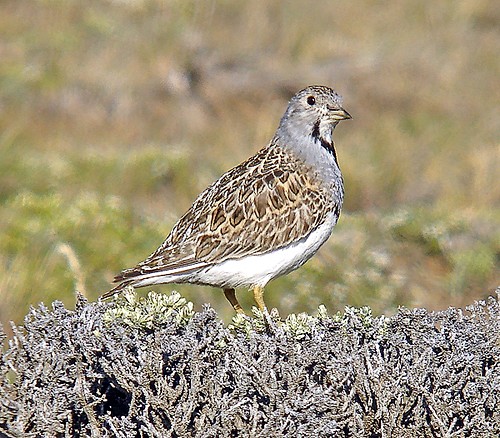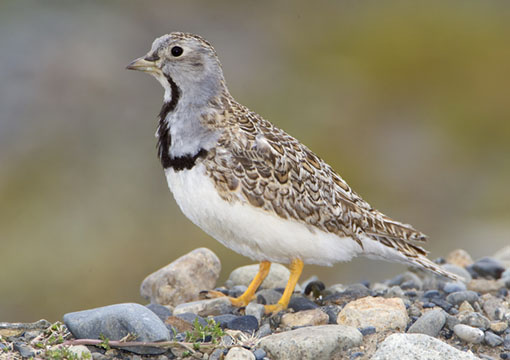
Thinocorus rumicivorus
TAXONOMY
Thinocorus rumicivorus Eschscholtz, 1829, Concepciуn Bay,
Chile. Three subspecies recognized (T. r. cuneidauda, T. r. bolivianus,
and T. r. rumicivorus) that differ in size, hue, and details
of vermiculations on the upperparts. A fourth, T. r. pallidus,
from the Santa Elena peninsula in southwestern Ecuador is often
listed, but it appears to be inseparable from T. r. cuneicauda.
OTHER COMMON NAMES
English: Chilean seedsnipe, Patagonian seedsnipe, Pygmy seedsnipe;
French: Thinocore de Patagonie; German: Zwerghцhenlдufer;
Spanish: Agachona Chica.
PHYSICAL CHARACTERISTICS
6–7 in (16–17 cm), T. r. bolivianus 8 in (19–20 cm); 1.8–2.1 oz
(50–60 g). Much like gray-breasted seedsnipe. Upperparts with
cryptic pattern of whitish, buff, and dusky; light borders narrowest
in juvenile. Throat and belly white, demarcated with
blackish (more broadly so than in gray-breasted seedsnipe) towards
face and breast, which are gray in male and streaked
dusky and buff in female. Male with blackish borders of throat
and breast connected by blackish line down center of breast.
Tail prominently white-tipped and distinctly wedge-shaped. In
flight shows a faint white wingbar above and a broad white
wingbar below, contrasting with the dark wing linings. Juveniles
much like females, but white throat not distinctly demarcated
and breast diffusely spotted rather than streaked.
DISTRIBUTION
T. r. cuneicauda: coastal desert of Peru and extreme northern
Chile, and, at least formerly, southwestern Ecuador; T. r. bolivianus:
altiplano of northwestern Argentina, Bolivia, and northern
Chile; T. r. rumicivorus: lowlands to 3,900 ft (1,200 m) in
Patagonia and southern Chile where partly migratory, wintering
north as far as the plains of northeastern Argentina and
Uruguay, the mountains of Cуrdoba (to above 6,600 ft [2,000
m]) and Atacama, Chile.
HABITAT
Sandy areas with scattered bunch grass, low herbs, and succulents.
In Patagonia, often on wide gravelly shores and areas
with tiny annual herbs around partly dry claypan lakes. In Bolivia,
in highland semidesert. In Peru, in sparse fog vegetation
of coastal desert. Often on cultivated land.
BEHAVIOR
In pairs or family groups, in winter in larger flocks. Territorial
males countersing from tops of bushes or fence posts. Display
flight much like that of gray-breasted seedsnipe. When flushed,
flies with snipe-like zigzag flight.
FEEDING ECOLOGY AND DIET
Like gray-breasted seedsnipe, browses on tips or buds of young
grass, succulents, and small herbs, which are swallowed whole.
REPRODUCTIVE BIOLOGY
Probably multibrooded. Young apparently sexually mature
when four months old and possibly breed the same season they
were hatched. Nest is a simple scrape loosely lined with plant
debris. Four eggs, covered with earth or nest-lining material
when not incubated. Length of incubation period about 26
days. Both parents guard the young, which fly when seven
weeks old.
CONSERVATION STATUS
Apparently favored by sheep grazing in Patagonia and irrigation
in the Peruvian desert. Common to locally abundant in
Patagonia. Ten specimens were collected on the Santa Elena
peninsula in southwestern Ecuador in 1898. Although taken in
January and February (the presumed breeding season), all were
in fresh plumage and may have been mere stragglers from
Peru. Subsequently there are but two possible sightings from
Ecuador. If those ten specimens did breed in Ecuador, the reason
for their disappearance remains unknown because plenty of
seemingly suitable habitat persists.
SIGNIFICANCE TO HUMANS
None known.
Photo Gallery of - Least seedsnipe




 Animalia Life
Animalia Life